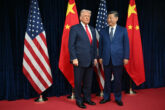February 02, 2024
Mind the Gap: America Needs an Office of Technology Net Assessment
Just over 50 years ago, Secretary of Defense James Schlesinger stood up an independent body within the Pentagon called the Office of Net Assessment. It was 1973, and the Cold War had entered a period of detente. The previous year, President Nixon had made a historic visit to Moscow, and the two superpowers signed the Strategic Arms Limitation Talks (SALT) I treaty to reduce their strategic nuclear arsenals. Amid the shifting geopolitical landscape, the ONA was empowered to step back, look ahead, and soberly assess the U.S. military’s “net” strengths vis-a-vis its competitors. A half-century after its founding, the ONA has its admirers and its detractors, but few would dispute the value of creating space within government for long-term, strategic analysis.
Policymakers have begun to recognize the need for this type of long-term technology analysis.
Today, there is a grave and growing gap in Washington’s long-term analysis: technology competition. Although the ONA has done laudable analyses of key technology trends, its focus on how those trends specifically affect the U.S. military misses the ever-expanding role technology plays in national and economic security. And within the ONA, technology competes with many other analytic priorities, even as technology leadership becomes more central to national power and the U.S.-China strategic competition in particular.
The analytic gap within the U.S. government for long-term technology trends is not a matter of speculation. It is painfully clear from three recent examples: semiconductors, 5G networks, and biotechnology.
Read the full article from Lawfare.
More from CNAS
-
Indo-Pacific Security / Technology & National Security
CNAS Insights | The Cost of Silence on China’s Cyber AggressionJust weeks before the much anticipated meeting between President Donald Trump and General Secretary Xi Jinping, the United States discovered yet another major China-backed cyb...
By Morgan Peirce
-
Defense / Technology & National Security
What to Expect from Military AI in 2030As the US military races to harness artificial intelligence, experts say the biggest AI breakthroughs may not come from “killer robots” or autonomous war machines, but from al...
By Josh Wallin
-
Defense / Indo-Pacific Security / Technology & National Security
To Compete with China on Military AI, U.S. Should Set the StandardsThe United States has an opportunity to lead in global norms and standards for military AI at a critical moment, when the foundations laid today could shape how militaries use...
By Jacob Stokes, Paul Scharre & Josh Wallin
-
Defense / Energy, Economics & Security / Technology & National Security
The Outlook CEO Perspectives on Risk, Resilience and ReturnsJoin David Schwimmer and Richard Fontaine, CEO of the Center for New American Security, as they explore the current national security landscape and its impacts on global econo...
By Richard Fontaine




